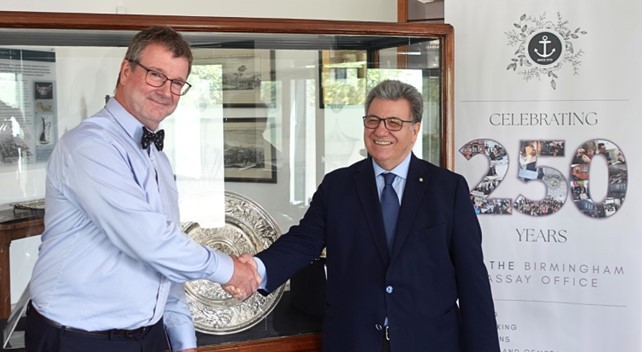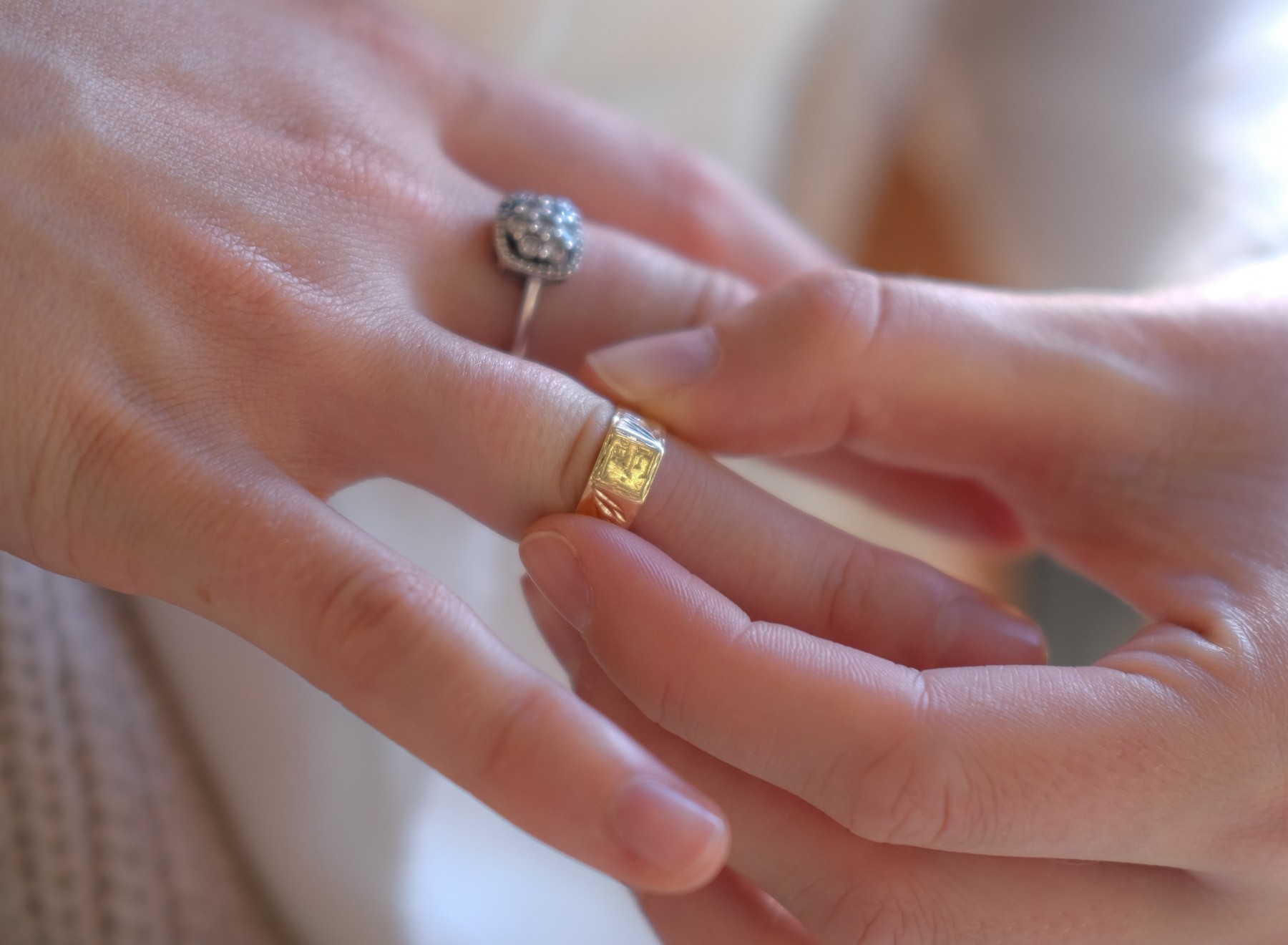 One of the rarest (and undoubtedly one of the most beautiful) books in the Library at The Birmingham Assay Office is our copy of William Morrisâs Kelmscott Chaucer, which was published in 1896.
Our book is one of 425 quarter-linen bound copies printed on hand-made linen paper, which originally retailed for £20. A small number of copies were also bound in vellum. The typeface, ornaments and decorative initials within the text were designed by William Morris. His close friend, the painter Sir Edward Burne-Jones, who was born in Birmingham, produced the 87 illustrations. They worked on the book for four years.
Burne-Jonesâ pencil drawings were painted over in Chinese white and Indian ink by Robert Catterson-Smith, who later became Headmaster of the Birmingham Municipal School of Art. The black and white designs were transferred to wooden blocks and engraved by William Harcourt Hooper.
The Works of Geoffrey Chaucer (to give the book its full name) was the last book to be published at the Kelmscott Press whilst Morris was still alive.
One of the rarest (and undoubtedly one of the most beautiful) books in the Library at The Birmingham Assay Office is our copy of William Morrisâs Kelmscott Chaucer, which was published in 1896.
Our book is one of 425 quarter-linen bound copies printed on hand-made linen paper, which originally retailed for £20. A small number of copies were also bound in vellum. The typeface, ornaments and decorative initials within the text were designed by William Morris. His close friend, the painter Sir Edward Burne-Jones, who was born in Birmingham, produced the 87 illustrations. They worked on the book for four years.
Burne-Jonesâ pencil drawings were painted over in Chinese white and Indian ink by Robert Catterson-Smith, who later became Headmaster of the Birmingham Municipal School of Art. The black and white designs were transferred to wooden blocks and engraved by William Harcourt Hooper.
The Works of Geoffrey Chaucer (to give the book its full name) was the last book to be published at the Kelmscott Press whilst Morris was still alive.
 William Morris was born into an affluent family in Walthamstow in 1834. He studied at Oxford, which is where he met Burne-Jones. The pair became friends with Dante Gabriel Rossetti, Ford Madox Brown and other members of the Pre-Raphaelite circle. They were also influenced by the writings of John Ruskin, who called for a return to handcraftsmanship in industry rather than unrestrained, mechanised mass production.
Morris, Burne-Jones and Rossetti were some of the founder members of Morris and Company, a commercial firm that aimed to produce handcrafted furniture, textiles, wallpapers and other goods as a reaction to the poor quality of machine made products that the young artists saw around them. The firm became successful, and Morris set up the Kelmscott Press to put hand production and craftsmanship back into book design, encompassing both printing and binding. He was inspired by the pioneers of printing in the 15th century, and named the press after Kelmscott Manor, his own home. The press was based at 16, Upper Mall, Hammersmith.
Turning the pages of the Kelmscott Chaucer is a unique experience. The book becomes an art object in its own right. You can feel the vitality in its design (the highly decorative, floral borders designed by Morris are reminiscent of some of his finest wallpaper designs) and the traditional techniques used in its production.
William Morris was born into an affluent family in Walthamstow in 1834. He studied at Oxford, which is where he met Burne-Jones. The pair became friends with Dante Gabriel Rossetti, Ford Madox Brown and other members of the Pre-Raphaelite circle. They were also influenced by the writings of John Ruskin, who called for a return to handcraftsmanship in industry rather than unrestrained, mechanised mass production.
Morris, Burne-Jones and Rossetti were some of the founder members of Morris and Company, a commercial firm that aimed to produce handcrafted furniture, textiles, wallpapers and other goods as a reaction to the poor quality of machine made products that the young artists saw around them. The firm became successful, and Morris set up the Kelmscott Press to put hand production and craftsmanship back into book design, encompassing both printing and binding. He was inspired by the pioneers of printing in the 15th century, and named the press after Kelmscott Manor, his own home. The press was based at 16, Upper Mall, Hammersmith.
Turning the pages of the Kelmscott Chaucer is a unique experience. The book becomes an art object in its own right. You can feel the vitality in its design (the highly decorative, floral borders designed by Morris are reminiscent of some of his finest wallpaper designs) and the traditional techniques used in its production.
 The Kelmscott Chaucer represents the pinnacle of Morrisâs attempts to reunify 19th century mass production with handcraftsmanship. However, the fact that the books made at the Kelmscott Press utilised hand production meant that they were expensive to buy, which was the inherent problem with the Arts and Crafts Movement despite its socialist aims.
Burne-Jones wrote about the Chaucer: âIf we live to finish it ... it will be like a pocket cathedral â so full of design and I think Morris the greatest master of ornament in the world.â
Sadly, Morris died in the year it was published and Burne-Jones died in 1898.
If you would like to know more about the Kelmscott Chaucer, visit http://kelmscottchaucer.wordpress.com. This is the blog for the book âThe Kelmscott Chaucer: A Censusâ, by William S and Sylvia Holton Peterson, published by Oak Knoll Press in April 2011. The authors are documenting copies of the Kelmscott Chaucer worldwide.
For further information about William Morris visit www.williammorrissociety.org.
The Kelmscott Chaucer represents the pinnacle of Morrisâs attempts to reunify 19th century mass production with handcraftsmanship. However, the fact that the books made at the Kelmscott Press utilised hand production meant that they were expensive to buy, which was the inherent problem with the Arts and Crafts Movement despite its socialist aims.
Burne-Jones wrote about the Chaucer: âIf we live to finish it ... it will be like a pocket cathedral â so full of design and I think Morris the greatest master of ornament in the world.â
Sadly, Morris died in the year it was published and Burne-Jones died in 1898.
If you would like to know more about the Kelmscott Chaucer, visit http://kelmscottchaucer.wordpress.com. This is the blog for the book âThe Kelmscott Chaucer: A Censusâ, by William S and Sylvia Holton Peterson, published by Oak Knoll Press in April 2011. The authors are documenting copies of the Kelmscott Chaucer worldwide.
For further information about William Morris visit www.williammorrissociety.org.
Your item has been added to the basket
You need to create an account, or login before you can add this item to your basket.







